Contents
Khajuraho Temples – What makes them special
Ancient temples
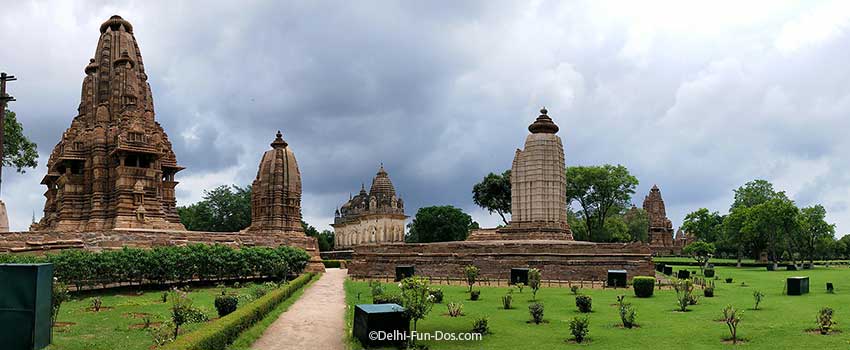
Have you ever had an ancient dream? Like really ancient!
Our dream of visiting Khajuraho dates back to Doordarshan or DD days. DD would telecast excerpts from the annual Khajuraho Dance Festival in the end of February every year. Classical dancers would perform in the backdrop of these stately temples that would look like magical mini mountains against a dark sky. With time, we came to know that these were a group of Hindu temples built between circa 950 and 1050 CE (Common Era) in Khajuraho, Madhya Pradesh. From about 85 temples, 25 temples have stood the test of time and are standing tall for more than a thousand years – yes they are that ancient. These 25 temples spread over 6 km are loosely classified as Eastern Wing, Western Wing and Southern or Jain group of temples.
The Khajuraho temples are a grand depiction of the glory of the Chandela dynasty, their religious beliefs, their lifestyle, and the opulence of that era. To give a brief background, the Chandela dynasty of Bundelkhand, Central India, rose to power in the 10th century. It was a prevalent practice to build magnificent temples to thank the Gods, display wealth, and celebrate success. Accordingly, various Chandela rulers built temples at Khajuraho, an area close to their capital at Mahoba in the Kalinjar area in present-day Madhya Pradesh. The Chandela dynasty could not survive the foreign invasions in the 13th century and Khajuraho was abandoned. The temples fell to disuse since then and were covered behind dense forests till they were discovered by British surveyor, T.S. Burt in the 1830s. The local villagers led him to these temples. Subsequently, the temples of Khajuraho in Chhattarpur, Madhya Pradesh were revealed to the world. The Khajuraho temples are declared UNESCO World Heritage site in India.
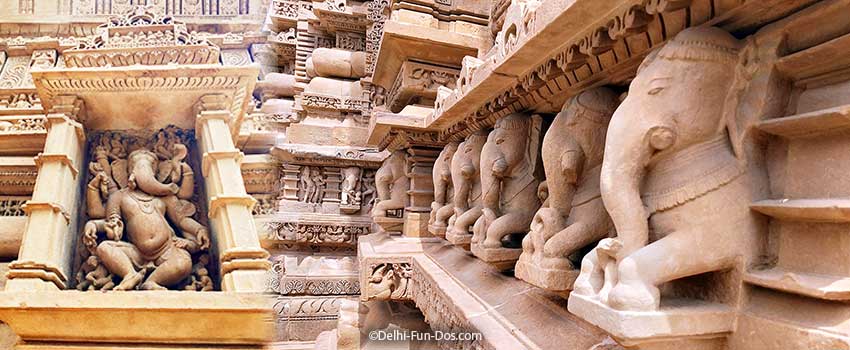
Madhya Pradesh is a treasure trove
It is really difficult to make a list of best places to visit in Madhya Pradesh. It boasts of the cream of tourist attractions of India – forests, mountains, waterfalls, ancient forts, and temples; MP has it all. Our earlier trip to Gwalior was an eye-opener and we did so much in just 3 days. So when we got this opportunity to visit Tendu Leaf Jungle Resort, which is 20 km or so from Khajuraho temples, we did not let it pass. Khajuraho temples feature in the top tourist attractions of Madhya Pradesh and it was our ancient dream..that was about to come true.
Poetry in stone
The grandiose temples are unparalleled stone art with a strong sense of movement. Most of the temples are carved out of sandstone with sporadic use of marble and granite. The statues on the temples, more often than not, depict motion. Women putting on anklets, painting their feet with red dye or alta, or applying kohl on the rim of their eyes. Men are depicted hunting, playing dice games, or engaging in various vocations. The thousands of statues that have been placed on the temples are different from each other. Yet they are tied in some chiselled harmony and at a first glance they all look so in place. The intricate carvings just blew our mind. Each pearl on a necklace or a waist chain was perfectly carved.
The temples are mostly dedicated to Lord Shiva, Ganesha, Vishnu, Goddess Jagaamba, Lakshmi and Jain Gurus. Some of the temples still had statues of the presiding deity in the sanctum sanctorum. The Shiva idol in the Viswanath Temple, the idol of the goddess in the Jagdamba Temple, Lakshmi idol at the Lakshmi temple, the huge idol of the Sun God at the Chitragupta temple and Guru Adinath idol in the Jain temples exuded a certain calm glory. These statues filled us simultaneously with joy and awe. But not only the deities, the common people, animals, flowers and trees and general ornamental motifs were also carved with meticulous precision with not a line out of place. We could see why the Khajuraho temples are called “Poetry in Stone”.
Apart from visual beauty, one cannot but marvel at the fantastic management of logistics that was involved in a day and age without electronic support. All the temples have been created with a strong sense of the Indian science of architecture – Vastu. The sanctum sanctorum of most temples faces the sun so that the sun rays illuminate the sacred chambers in the morning. What is even more marvelling is that there was no use of grout or mortar to join the various pieces in the structures. Precisely carved inter locking systems did the job of installing the many many statues at varying heights as well as holding even very heavy pillars. Sadly this skill is lost for good and modern renovations of Khajuraho temples using brick and mortar have aged and discoloured much faster than the original joints.
Erotic sculptures of Khajuraho temples
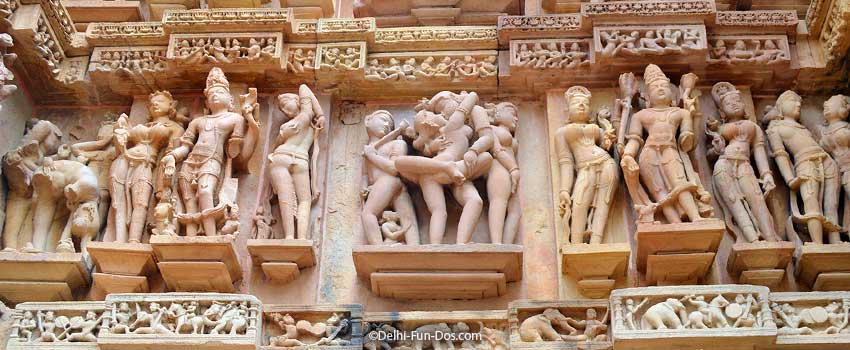
Khajuraho temples draw huge attention as temples of eroticism. As per Mr. Govind, our able guide at Khajuraho temples, about 10% of the statues on the temples denote erotic postures. There would be some reasons behind this. Firstly, union of man and woman is a spiritual practice in Tantric forms of Hinduism. Accordingly, eroticism is not out of place as temple carvings.
Moreover, Khajuraho temples portray the lifestyle of that era. The so-called erotic statues not only depict men and women in acts of copulation. They also show men and women in romantic mood holding hands, leaning against each other, dancing, or even drinking together. Evidently, that was a way more liberated era where the society accepted, and evidently celebrated, two people enjoying each other’s company in love. When we think about that, we are extremely saddened. Over time, instead of following the liberated path of love, Indian society became a conservative labyrinth with a host of dos and don’ts and unfair interference thrust on people’s personal affairs.
Given that the temples celebrate company and romance, it would not be fair to call Khajuraho monuments just temples of eroticism. They are rather – temples of love.
How to reach Khajuraho from Delhi
Overnight train
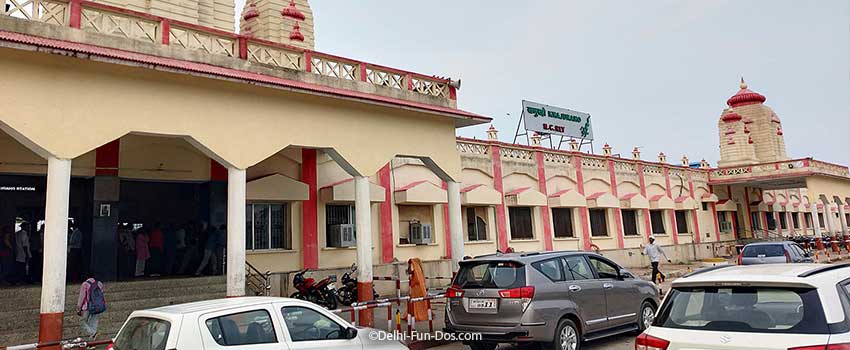
There are a host of overnight trains from Delhi to Khajuraho. We travelled on Uttar Pradesh Sampark Kranti Express from Hazrat Nizamuddin Station. The train started at 8 in the evening and after a comfortable overnight sleep, we were dropped at about 6.30 early next morning. There are other trains as well and it takes about 10 hours from Delhi to Khajuraho.
Flight
Khajuraho is now serviced by an airport. There were sporadic flights between Delhi and Khajuraho, but the frequency has increased over time. A host of airlines are now flying from Delhi to Khajuraho and flight time is about 3 hours with one stop at Varanasi. So, if you are short on time, flight is a great option.
Where to stay in Khajuraho
Many big, and small hotels and hostels near the temples
Khajuraho is a small town so wherever you put up, you are not very far from the temples. There are a host of hotels here from budget to medium to luxury and one is spoilt for choice. That said, Khajuraho is a popular destination during winter and other holiday season. It may therefore be pragmatic to book room ahead.
Tendu Leaf Jungle Resort, Panna Forest Reserve
Our accommodation was in the lap of nature. Tendu Leaf Jungle Resort is located at the periphery of Panna Forest Reserve. It took us about 20 minutes by car to reach the temples from our resort. Balancing between lush greenery on riverside and grand ancient temples, we got the proverbial best of both worlds during our stay at Tendu Leaf.
Visit to Khajuraho temples is a vast experience. We visited the temples on two days and spent and about 6 to 8 hours during each visit. There are other attractions in Khajuraho that we covered too. Consequently, we have so much more to share. Stay tuned for our next post on this subject.

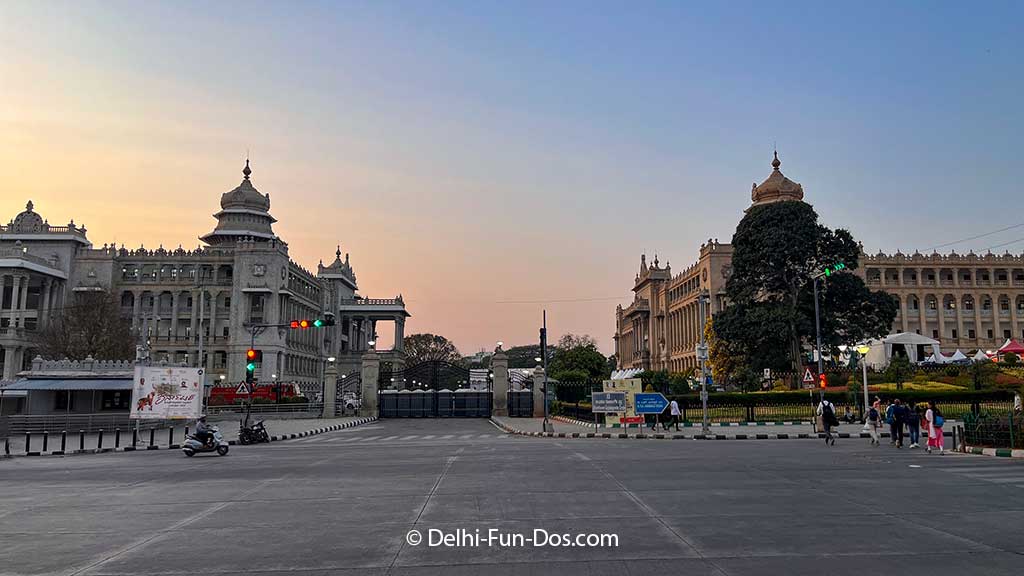
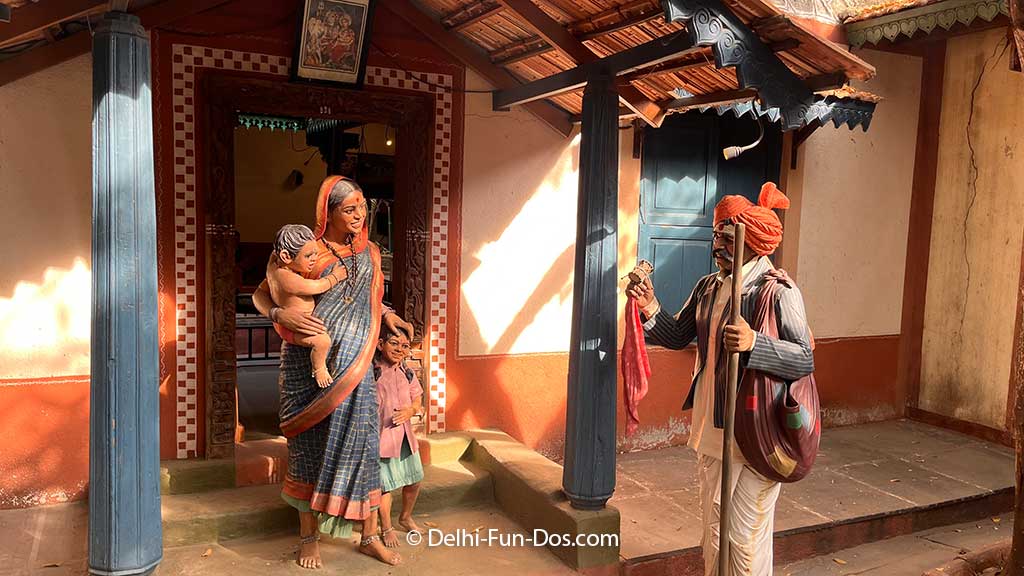
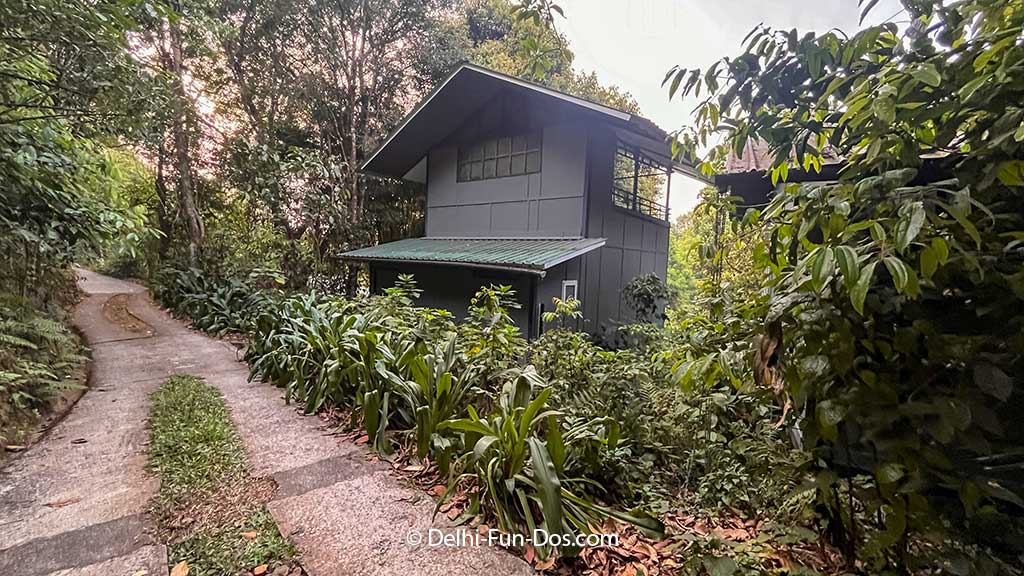
Thanks for a marvelous posting! I really enjoyed reading it, this post is very interesting and informative. Thanks for sharing.
Glad you liked it!
Whoa! Khajuraho looks like a very intriguing area to visit. It also, sounds like it would be an amazing place to visit during the dance festival in February. Great insight!
It is mind blowing.
I would love love love to spend a week there, the place is out of this world wow.
Tendu Leaf Jungle Resort is where I want to go one day! I’ve heard some pretty fantastic things about it!
It was a wholesome experience.
It is a long trip, but would love to go there. So much to learn from these magical traveling experiences!
Assure you it is totally worth!
I didn’t go to khajurao but I have been to Bhopal and there I went to Bheem Batika. The cave painting there were amazing. The roads of Bhopal and the overall welcome by the people was amazing. MP is indeed gazab
We agree – Madhya Pradesh is amazing..
Khajurao temple and konark temple are one of the tops from my to visit places. I have been planning a trip to south for long and probably executing it in December.
Both are beautiful ..
Look at those nice carvings, I’d like to be able to see all those works of art in actual.
This looks like so much fun. I Have never heard of this city but now I want to go. Thanks for sharing
I really enjoyed the detailed post you have given on khajurao. I am a Traveller too and will definitely put this into my bucket list too.
You must must must.